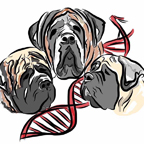
Epilepsy in Mastiffs
The Mastiff Club of America’s Seizure Disorder Sub-Committee is dedicated to helping owners of Mastiffs with seizures and encouraging participation in available Epilepsy Research Projects. Although Epilepsy is one of the most common causes of seizures in Mastiffs, we are committed to educating owners as to other conditions that should be ruled out before a diagnosis of Epilepsy can be made. If you have a Mastiff that is having seizures it is extremely important that you seek veterinary medical attention to correctly diagnose the cause of the seizures. We are also available to offer our support and to share additional information and resources on seizing Mastiffs. Epilepsy is a difficult disease to diagnose. It can easily be mistaken for a variety of other problems.
Please see the links below for more information or reach out to Carrie Nolin, MCOA Health Committee - Epilepsy and Seizure Disorder Chair, and/or Mary DeLisa, MCOA Health Committee Chair. We are here to help, not judge.
Epilepsy Research
The Mastiff Club of America Health Committee has identified several grants and/or research programs to support. The Health Committee has contributed $2500 to Grant 02930: A Dose Finding Study of Cannabidiol in Dogs with Idiopathic Epilepsy
What is Epilepsy?
Epilepsy (repeated seizure episodes) occurs in dogs (purebred and crossbred). There are many causes, but when the cause is unknown, it is characterized as “idiopathic” epilepsy. Heredity likely plays a role in many dogs with idiopathic epilepsy. The typical age of onset of seizures in dogs with idiopathic epilepsy is 1 to 3 years. It requires a Veterinary and or a Neurologist diagnoses.
Epilepsy is a broad term used to describe brain disorders that are characterized by recurrent and/or recurring seizures. There are several different types of epilepsy that can affect dogs, so it helps to understand the different vocabulary associated with each.
- Idiopathic epilepsy describes a form of epilepsy that does not have an identifiable underlying cause. However, idiopathic epilepsy is often characterized by structural brain lesions and is found more often in male dogs. If left untreated, the seizures may become more severe and frequent.
- Symptomatic epilepsy is used to describe primary epilepsy resulting in structural lesions or damage to the brain’s structure.
- Probably symptomatic epilepsy is used to describe suspected symptomatic epilepsy, where a dog has recurrent seizures, but where no lesions or brain damage is apparent.
- Cluster seizure describes any situation where an animal has more than one seizure in consecutive 24-hour periods. Dogs with established epilepsy can have cluster seizures at regular intervals of one to four weeks. This is particularly evident in large-breed dogs.
- Status epilepticus involves constant seizures, or activity involving brief periods where there is inactivity, but not complete relief from seizure activity.
Polygenic Inheritance
A polygenic trait or Phenotype is a characteristic that are affected by many different genes. A classic example of this would be height. If multiple alleles are needed to determine the makeup of a specific trait, the chance of developing a seizure disorder would evaluate the risk scales of both parents.
Simple Recessive Inheritance
The most common explanation in most seizure disorders, neither parent exhibit traits but have offspring is affected. Both the sire and damn need to have the recessive gene to pass it on.
Besides epilepsy, a few different things can cause seizure activity in dogs, including certain poisons, fever, diabetes, anemia, strokes, or head injuries. One major area for concern is a dog’s confusion after an episode resulting in panic. This panic can result in unintentional dog bites, so it’s important to remain cautious when approaching a seizing dog or animal that has just come out of an episode. Keep all children and other animals away.
Types of Seizures
Typically, there are three main types of seizures with dogs.
Grand Mal Seizure
A Grand Mal seizure affects the electrical activity throughout the brain. These generalized seizures will typically last a few seconds to a few minutes at a time. Seizure activity of this type can cause convulsions and loss of consciousness in the animal.
Focal Seizure
A Focal Seizure affects only part of the brain. These seizures can impact one part of the body instead of the entire body. It’s important to remember that a focal seizure may only last a few seconds. A partial seizure in dogs affects only a small part of the brain and can manifest a couple different ways, but will typically progress to grand mal seizures throughout the dog’s lifetime. When a dog is having a partial seizure, only one limb, side of the body, or just the face will be affected.
Psychomotor Seizure
A Psychomotor seizure changes an animal’s behavior rather than a physical manifestation. A dog experiencing a psychomotor seizure will have strange or abnormal behavior repeatedly. Examples of this would be chasing their tail or swimming with a compulsive nature.
Please always refer to your own Veterinarian or Neurologist for any diagnoses or treatment plan.
Helpful Resources
The Canine Epilepsy Network is an excellent website with understandable information about epilepsy, its causes, treatments, and living with epileptic dogs. After accessing the main page, click on “Canine Epilepsy Basics”. Another site with links to additional epilepsy resources (at bottom of page) is located at the AKC Canine Health Foundation Epilepsy Research Initiative.
Studies & Trials
The Canine Epilepsy Research Consortium headed by the University of Minnesota and the University of Missouri Columbia is studying the genetics of epilepsy in all dog breeds. They are interested in collecting samples from ANY PUREBRED DOG.
Updated: 05/18/2025